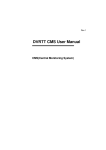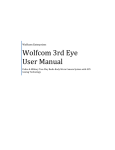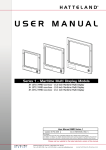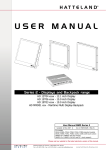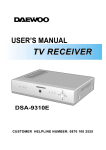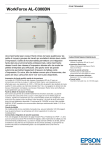Download CDA CPX10 User`s manual
Transcript
User’s Manual InnoLas Flipper IL-F300 Instructions for Operators, Service Personnel, and OEMs Doc. Man IL-F300 Version 1.02/08-2008 ©2008 InnoLas GmbH InnoLas GmbH Justus-von-Liebig-Ring 8 D-82152 Krailling / Germany Tel.: ++49 (0)89 899 360 0 Fax.: ++49 (0)89 899 360 16 E-mail: [email protected] Web: www.innolas.com IL-F300 Table of Contents Table of Contents Flipper IL-F300 ........................................... 1 1 How to use this manual . . . . . . . . . . . . . . . . . . . . . . . . . . . . . . . . . . 1 2 Safety Instructions . . . . . . . . . . . . . . . . . . . . . . . . . . . . . . . . . . . . . . 2 2.1 3 3 3 3 4 Shipment . . . . . . . . . . . . . . . . . . . . . . . . . . . . . . . . . . . . . . . . . 5 General Description . . . . . . . . . . . . . . . . . . . . . . . . . . . . . . . . . . 5 Installation . . . . . . . . . . . . . . . . . . . . . . . . . . . . . . . . . . . . . . . . . . . . 6 4.1 4.2 5 . . . . General . . . . . . . . . . . . . . . . . . . . . . . . . . . . . . . . . . . . . . . . . . . . . . 5 3.2 3.2 4 Warning Labels . . . . . . . . . . . . . . . . . . . . . . . . . . . . . . . . . . . . Structure of warning labels . . . . . . . . . . . . . . . . . . . . . . . . . . . . Symbol Definition . . . . . . . . . . . . . . . . . . . . . . . . . . . . . . . . . . . Safety Instructions. . . . . . . . . . . . . . . . . . . . . . . . . . . . . . . . . . . Flipper base . . . . . . . . . . . . . . . . . . . . . . . . . . . . . . . . . . . . . . . 6 CDA Supply, Power Supply, and Controlling . . . . . . . . . . . . . . . . . . . 7 Adjustments . . . . . . . . . . . . . . . . . . . . . . . . . . . . . . . . . . . . . . . . . . . 9 5.1 5.2 5.3 Wafer Size . . . . . . . . . . . . . . . . . . . . . . . . . . . . . . . . . . . . . . . Flipping Velocity and Close Function . . . . . . . . . . . . . . . . . . . . . . Wafer Recognition . . . . . . . . . . . . . . . . . . . . . . . . . . . . . . . . . . Adjusting the Beam Spot Size and Display . . . . . . . . . . . . . . . . . . . Manually Sensor Teaching via Two-Point Tuning . . . . . . . . . . . . . . . Sensor Teaching via Software . . . . . . . . . . . . . . . . . . . . . . . . . . . . 9 10 11 11 12 12 6 Developer Information . . . . . . . . . . . . . . . . . . . . . . . . . . . . . . . . . . 14 7 Technical Specifications . . . . . . . . . . . . . . . . . . . . . . . . . . . . . . . . . 15 7.1 7.2 7.3 7.4 7.5 7.6 7.7 Dimensions Flipper . . . . . . . . . . . . Dimensions Festo CPX . . . . . . . . . . Packing . . . . . . . . . . . . . . . . . . . Power Supply CPX . . . . . . . . . . . . . Air Supply . . . . . . . . . . . . . . . . . . Interfaces Flipper . . . . . . . . . . . . . Interfaces Festo CPX . . . . . . . . . . . Doc. MAN IL-F300 Vers. 1.02 ...................... ...................... ...................... ...................... ...................... ...................... ...................... ©2008 InnoLas GmbH 15 15 15 15 15 15 15 Page I IL-F300 System Description Flipper IL-F300 1 How to use this manual This manual provides all necessary information for installing, commissioning, adjusting, and operating the Flipper. In certain cases the manual refers to third-party manuals. These manuals are included in the scope of delivery and it’s important to read these manuals too. Safety Instructions First of all read the chapter 2 Safety Instructions very carefully. This chapter provides all necessary information to safeguard the operator and the machine against any hazards. Every safety instruction is repeated at the respective location in the text. Text and Pictures The pictures in the left column complete the text in the right column of the respective page. Numbering Points of interrest in a picture are referenced by a number. The numbering starts with (1) at every new page even if the picture is used more than once in a chapter. You’ll find the description of the numbered points of interrest in the text on the same page referred by the respective number. So the text and picture on one page have a very close relation. Instructions Instructions that need a direct action by the operator, the service personnel or any other personnel are marked at the beginning by a Subitems • To make the description clearer the text uses subitems that are marked by small bullets • at its beginning. Hyperlinks The electronic version of the manual uses hyperlinks that are marked blue, italic, and underlined. If you click a hyperlink you can jump to further information.To return to the previous view click onto the jump destination. Even if not marked the table of contents uses hyperlinks. Doc. Man IL-F300 Vers. 1.02 ©2008 InnoLas GmbH Page 1 IL-F300 2 System Description Safety Instructions This product is manufactured in accordance with state of the art technology and corresponds to recognized safety regulations. Nevertheless, there are dangers associated with the use of the equipment even for its intended purpose. Therefore: Read this chapter carefully. Always follow the operating instructions to ensure proper operation of the systems. Always follow the safety instructions to avoid any accidents, trouble, or injuries. The operation manual contains all necessary information for the intended use of the InnoLas Flipper and its relevant components as well as its operation. Only specially qualified personnel may operate or maintain the InnoLas Flipper and its components to avoid severe danger to the personnel or the machine. The following chapter describes the safety instructions for the InnoLas Flipper. Both the responsible personnel and every person that will operate the machine directly or indirectly must read and respect these safety instructions. Neglecting the safety instructions may cause severe injuries to personell or to the machine. Doc. Man IL-F300 Vers. 1.02 ©2008 InnoLas GmbH Page 2 IL-F300 System Description 2.1 Warning Labels Structure of warning labels Pos 1 2 3 4 Danger! Danger to life or system damage Description 1 Warning sign (the sign varies, see „symbol definition“ on page 2 2 Warning bars: thickness is according to the warning level; 3 Warning heading: Always turn off mains voltage and compressed air of the system before installing the Flipper. 4 DANGER indicates a hazardous situation which has a high probability of death or severe injury WARNING indicates a hazardous situation which has some probability of death or severe injury CAUTION indicates a hazardous situation which may result in minor or moderate injury NOTICE indicates a statement of company policy as the message relates directly or indirectly to the safety of personnel or protection of property. Warning text: describes the danger and how to prevent it; Symbol Definition Warning LASER Radiation Danger/Notice General operating Advice Doc. Man IL-F300 Vers. 1.02 ©2008 InnoLas GmbH Page 3 IL-F300 System Description Safety Instructions Danger! Danger to live or system damage Always turn off mains voltage and compressed air of the system before installing the Flipper. Warning! LASER Radiation Class 2 LASER product. Do not stare into beam! Notice! System mal function To avoid twisting the wafer take care that you adjust all 4 grub screws to exactly the same position. Notice! System mal function Never try to adjust any of the other screws. Readjusting the wafer clamps is extremely difficult. Doc. Man IL-F300 Vers. 1.02 ©2008 InnoLas GmbH Page 4 IL-F300 3 System Description General 3.1 Shipment The InnoLas ILF 300 Flipper system is shipped with the Flipper base, the Flipper controller (Festo), compressed air hoses, a 24-V-plug for the Festo controller, and a connection cable with 2 Sub-D 25 connectors. Pic. ILF 300 Bild 1 Depending on your order the Festo CPX terminal is included or not. ILF 300 1-01 Flipper Scope of Delivery 3.2 General Description The Flipper ILF 300 is Edge Grip based (PEEK pins) and is intended for flipping over 300 mm wafers during the handling process. Pic. ILF 300 Bild 14 The Flipper system consists of the Flipper station itself and a controller. InnoLas systems use a Festo CPX Terminal to control the Flipper. The wafer recognition is done by a LASER sensor that must be adjusted for the wafer reflection. Homing of the Flipper to position 0° is always done during initialization or directly before the Flipper is loaded if necessary. ILF 300 1-02 Flipper in Flipping Action With InnoLas Sorters C3800 a wafer is only be flipped at the beginning or at the end of a job. This is valid for every operation mode. That means flipping is only possible directly after a wafer was carried from a cassette or directly before a wafer is brought back to the cassette. Pic. ILF 300 Bild 4 2 The Flipper locks the wafer by edge grip via 2 PEEK pins at the lower clamp (1) and 2 PEEK pins at the upper clamp (2) at both Flipper arms. 1 1 ILF 300 1-03 Doc. Man IL-F300 Vers. 1.02 With InnoLas Sorters C3800 the flipping operation for a wafer processes always from position 0° to position 180°. 2 Flipper Edge Grip ©2008 InnoLas GmbH Page 5 IL-F300 4 System Description Installation Danger! Danger to life or system damage Always turn off mains voltage and compressed air of the system before installing the Flipper. 4.1 Flipper base (1) The Flipper base plate provides 3 holes for fixing the Flipper on a mounting plate. Pic. ILF 300 Bild 22 Use 3 Allen scews DIN 912 M8 x25 (or an appropriate size for your mounting plate) to fix the Flipper to the mounting plate. The screws are not included in the scope of delivery. 2 (2) The Flipper base plate provides 4 threads to adjust the height above the mounting plate or to adjust the pitch of the Flipper. Use 4 grub screws (3 mm hex wrench) to adjust the height or pitch of the Flipper. 1 Picture 1-05 shows the Flipper scale drawing with all important measurements. 2 ILF 300 1-04 Flipper Mounting Pic. ILF 300 Bild 2 2 1 2 ILF 300 1-05 Doc. Man IL-F300 Vers. 1.02 Flipper Scale Drawing ©2008 InnoLas GmbH Page 6 IL-F300 System Description 4.2 1 CDA Supply, Power Supply, and Controlling The Flipper base supports 4 Festo connectors for compressed air, 1 connector for particle exhaust, and 1 Sub-D connector. 2Pic.3 ILF 4 300 Bild 10 Compressed dry air (CDA) needs 6 bar. 6 5 7 (1) Set 0° compressed air input to flip the wafer into default position (2) Set 180° compressed air input to flip over the wafer into 180° position ILF 300 1-06 Flipper Interface (3) Close compressed air input for closing the clamp and fixing the wafer (4) Open compressed air input for opening the clamp and releasing the wafer (5) Exhaust connection for particle exhaust to protect the wafer against damage and contamination (6) D-Sub connector digital input and output for sensors and LASER (7) Hose fixings to fix the hoses via cable ties for strain relief and against unexpected movements Use the included hoses and the cable to connect the Flipper to the control unit. Pic. ILF 300 Bild 10 ILF 300 1-07 Connect the 4 CDA sockets Set 0°, Set 180°, Close, and Open to the respective compressed dry air (CDA) controller sockets via the 4mm hoses. Flipper Connection Connect the Exhaust socket via an 8 mm vacuum hose to a particle exhauster. Plug the Sub-D 25 connector to the Sub-D 25 socket of the Flipper. Doc. Man IL-F300 Vers. 1.02 ©2008 InnoLas GmbH Page 7 IL-F300 System Description You can use any controller to operate the Flipper. InnoLas systems use a Festo CPX Terminal. The following installation guide for the controller is shown as an example using a Festo CPX. Pic. ILF 300 Bild 13a Plug the Ethernet cable (14) to the LAN socket of the controller(Festo CPX Terminal). The system Ethernet sends the operation instructions for the Flipper. This could also be done via the RS232 interface (15). 15 14 16 ILF 300 1-08 Festo CPX Terminal Front Side Assemble the included power supply plug to an appropriate cable (refer to the Festo documentation for correct power rating). The pin assignment is shown on the plug package. Pic. ILF 300 Bild 21 (Red) Connect the power supply plug to the 24 V socket of the controller (13) and secure it. (Brown) View to plug inside Connect CDA socket of the CPX (10) to a 6 bar CDA supply via a 8 mm hose. Connect the CDA hoses from the Flipper to the respective impulse valve output sockets of the controller: (Blue) (Yellow-Green) ILF 300 1-09 Power Supply Plug Assembly 9 1 3 5 7 11 Pic. ILF 300 Bild 17b 13 12 10 ILF 300 1-10 2 Plug the Sub-D 25 connector (16) to the SubD 25 socket of the controller (CPX Terminal). 4 6 8 Festo CPX Terminal Upper Side (1): (2): (3): (4): Set 0° Set 180° Close Open Positions 5 to 8 are not used. Connect the PFO socket (9) of the controller via a 10 mm exhaust air hose outside the machine or directly to a silencer. Connect the power supply cable to a 24 V direct current voltage power supply. Description of valve connections (1) (2) (3) (4) (5) (6) (7) Doc. Man IL-F300 Vers. 1.02 ©2008 InnoLas GmbH Set 0° Set 180° Close Open Free Free Free (8) (9) (10) (11) (12) (13) Free PFO out CDA in PFO leave opened Keep closed Power supply Page 8 IL-F300 5 System Description Adjustments 5.1 Wafer Size The Flipper is intended for use with wafers of a diameter of 300 mm ± 2 mm. Pic. ILF 300 Bild 20 1 The wafers should not be clamped tightly by the clamp and the PEEK pins. Therefore the diameter of the PEEK pins is not important. The right Flipper clamp width (1) for the respective wafer size is adjusted during assembly. You can adjust this clamp width to the true wafer size in small increments using the grub screws (2) (2 mm hex wrench). Notice! System mal function ILF 300 1-11 Flipper Gripper Width Never try to adjust with any of the other screws. Re-adjusting the wafer clamps is extremely difficult. 2 2 ILF 300 Bild 18a Pic. Fix the grub screws (2) with an Allen wrench and loosen the lock nuts (3) with a screw wrench. Always loosen both lock nuts of a boom first before you alter the grub screws. 3 2 ILF 300 1-12 Screw the grub screws (2) clockwise to increase the clamp width or counter clockwise to decrease the width. Flipper Grub Screws Notice! System mal function To avoid twisting the wafer take care that you adjust all 4 grub screws exactly in the same amount. Ensure that all alignments of the grub screws are equal. This means, e.g., if you alter one of the grub screws a quarter turn clockwise you must also alter the other grub screws a quarter turn clockwise. To fix the positions of the grub screws hold them with the Allen wrench and tighten the lock nuts with the wrench. Doc. Man IL-F300 Vers. 1.02 ©2008 InnoLas GmbH Page 9 IL-F300 System Description 5.2 Every CDA input of the Flipper is controlled by a CDA regulator. These CDA regulators enable the adjustment of the flipping velocity and the „Close“ function. Pic. ILF 300 Bild 23 1 2 3 Flipping Velocity and Close Function 4 To reduce CDA pressure and velocities and to increase the time period, turn the adjustment button clockwise. To increase the CDA and velocities and reduce the time period, turn the adjustment button counter clockwise. (1) Adjustment of flipping velocity to positon 0° (2) Adjustment of flipping velocity to positon 180° ILF 300 1-13 Flipper CDA Regulators (3) Adjustment of the time period untill the „Close“ drives will reach their end position. The base adjustment of this regulator is 1.5 turns (540°) counter clockwise from closed state. Notice: The regulator „Close“ does not affect the closing velocity of the clamps. (4) Adjustment of the opening velocity of the clamp. Notice: You should preferably select a slower opening time. Doc. Man IL-F300 Vers. 1.02 ©2008 InnoLas GmbH Page 10 IL-F300 System Description 5.3 Pic. ILF 300 Bild 12a ILF 300 1-14 5 8 7 Flipper LASER Sensor Wafer Recognition Wafers are detected via a LASER sensor. A LASER diode (5) transmits a LASER beam (6) via a focusing lens to the wafer. The wafer reflects the beam to the photo receiver (7). The amplifier (8) analyzes the signal for its light intensity. Regardless of your target distance, you can adjust the beam spot to meet your application needs. Adjusting the Beam Spot Size and Display Pic. ILF 300 Bild 19 Warning! LASER Radiation 6 Class 2 LASER product. Do not stare into beam! 1 Remove the cover plate (1). It’s fixed by 2 screws. Take care the LASER is on. Verify this by holding a piece of white paper into the beam. ILF 300 1-15 Flipper Wafer Detection Lay a wafer exactly on to the Flipper clamps. Turn the focus ring of the transmitter. Look for intensity value of about 5000 or lower at the upper red amplifier display (2). Pic. ILF 300 Bild 24 After completing the adjustment fix the focus ring by turning the focus lock screw vertically. Re-attach the cover plate. 2 5 Adjusting the sensor to detect in a distance range of 50 mm the spot diameter is about 0.3 mm. Adjusting the sensor to detect in a distance range of 300 mm the spot diameter is about 0.8 mm. ILF 300 1-16 3 Flipper LASER Sensor 4 (4) The red LED A (on) indicate that the automatically calculated threshold between wafer present and wafer not present was exceeded. This means wafer is present. 2 Pic. ILF 300 Bild 15 ILF 300 1-17 5 Doc. Man IL-F300 Vers. 1.02 (3) The green LED (on) indicates an active LASER. (5) The green display shows the automatically calculated threshold between wafer present and wafer not present and is dark during threshold calculation. Flipper LASER Sensor Amplifier For more information refer to the Keyence manual. ©2008 InnoLas GmbH Page 11 IL-F300 System Description Manual Sensor Teaching via Two-Point Tuning Warning! LASER Radiation Class 2 LASER product. Do not stare into beam! You must teach the sensor for wafer recognition. Take care that the beam spot size is already adjusted and no wafer is on the Flipper. 2 4 1 Pic. ILF 300 Bild 15 Maybe you must de-activate the key lock first. To de-activate the key lock press the MODE (1) button together with the „up“ or „down“ (3) button for about 3 seconds respectively until „un L“ starts flashing in the display to deactivate the key lock. Push the SET button (4) untill you get a steady display. 5 ILF 300 1-18 Lay a wafer exactly on to the Flipper clamps. 3 Flipper LASER Sensor Amplifier Push the SET button (4) again untill you get steady display. Sensor teaching is now complete.The red display (2) shows the current reflection intensity. The green display (5) shows the automatically calculated threshold between wafer present and wafer not present (no display during calculation). For more information refer to the Keyence manual. Sensor Teaching via Software Warning! LASER Radiation Class 2 LASER product. Do not stare into beam! With InnoLas Sorter C3800 systems service personnel can teach the wafer recognition for the sensor via software. Take care that the beam spot size is already adjusted. To teach the sensor via software the key lock of the amplifier must first be activated. Doc. Man IL-F300 Vers. 1.02 ©2008 InnoLas GmbH Page 12 IL-F300 System Description 2 In normal sorter operation the keys of the amplifier are already locked. If not follow the next instruction. 1 To activate the key lock press the MODE (1) button together with the „up“ or „down“ (3) button for about 3 seconds respectively until „Loc“ starts flashing in the display. Pic. ILF 300 Bild 15 The amplifier keys are now locked. 5 3 ILF 300 1-19 Lay a wafer exactly on to the Flipper clamps. Flipper LASER Sensor Amplifier In the InnoLas Sorter software open the menu Service / Flipper. In the Flipper dialog box mark the „Manual“ checkbox (4). Pic. ILF 300 Bild 26 Mark the checkbox Sensor on / off (6). 6 2 8 5 Unmark the checkbox Laser off /on (7) to activate the LASER. The light yellow icon (8) indicates an active LASER. Mark the checkbox „Calibrate Sensor“ (9). Wait about 3 seconds. Unmark the checkbox „Calibrate Sensor“ (9). 7 9 Remove the wafer from the Flipper clamps. 10 ILF 300 1-20 4 Mark the checkbox „Calibrate Sensor“ (9). Flipper Sensor Calibration Wait about 3 seconds. Unmark the checkbox „Calibrate Sensor“ (9). 2 1 Mark the checkbox „Automatic“ (10). Sensor teaching is now complete. The red display (2) shows the current reflection intensity. The green display (5) shows the automatically calculated threshold between wafer present and wafer not present (no display during calculation). Pic. ILF 300 Bild 15 For more information refer to the Keyence manual. 5 ILF 300 1-19 Doc. Man IL-F300 Vers. 1.02 3 Flipper LASER Sensor Amplifier ©2008 InnoLas GmbH Page 13 IL-F300 6 System Description Developer Information You can operate the Flipper with any controller. The Flipper needs a separat CDA supply for Pic. ILF 300 Bild 22 • flipping to position 0° • flipping to position 180° • closing the clamp • opening the clamp To control the Flipper operation you have to connect the Flipper via the Sub-D 25 socket to the controller. The pin configuration of the Sub-D 25 socket is shown in picture ILF 300 1-22. ILF 300 1-22 Flipper D-Sub Connector The connection circuit for the impulse valves of the controller that control the CDA for the Flipper movements is shown in picture ILF 300 1-23. Pic. ILF 300 Bild 28 ILF 300 1-23 Doc. Man IL-F300 Vers. 1.02 Flipper Sensor Valve Connection ©2008 InnoLas GmbH Page 14 IL-F300 7 System Description Technical Specifications 7.1 7.2 7.3 Dimensions Flipper Height: approx. 382.5 mm Width: approx. 435 mm Depth: approx. 180 mm Weight: approx. 8.9 kg Height: approx. 75 mm Width: approx. 260 mm Depth: approx. 125 mm Weight: approx. 1.6 kg Dimensions Festo CPX Packing Case 7.4 7.5 Carton (recycable), PE protection film (recycable) Power Supply CPX Input supply voltage 24 V DC Power input Flipper Flipper+CPX 155 mA 290 mA Pressure Pnorm: Pmax: Air Supply Compressed dry air (CDA) (input) 7.6 7.7 6 bar 8 bar Interfaces Flipper CDA input 4 x 4 mm Festo material: PBT, POM,NBR, SS Exhaust 1 x 8 mm Festo material: PBT, POM,NBR, SS Sensors D-Sub 25 socket Interfaces Festo CPX CDA input 8 mm material: PBT, POM,NBR, SS CDA output 4 x 4 mm material: PBT, POM,NBR, SS PFO 10 mm material: PBT, POM,NBR, SS Sensors D-Sub 25 socket Controlling RJ45 socket (Ethernet) or D-Sub 9 socket (serial) Doc. Man IL-F300 Vers. 1.02 ©2008 InnoLas GmbH Page 15


















